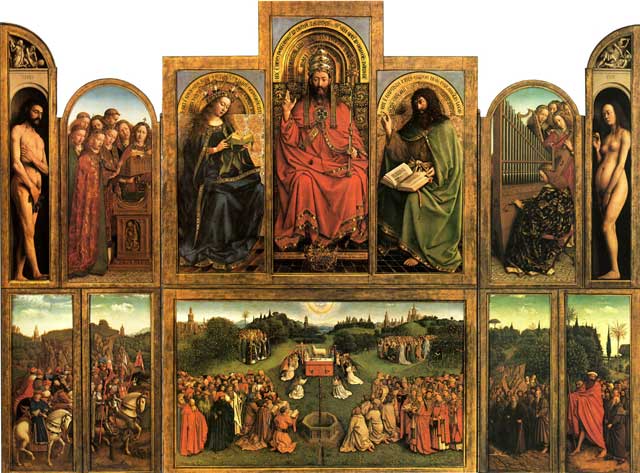Great Works: The Adoration of the Mystic Lamb, c1426-32 (375cm x 520 cm, open), Hubert and Jan van Eyck
St Bavo Cathedral, Ghent

Great systematizers, in literature, art, and theology, can be so marvellously seductive. We never cease to marvel and to wonder at the hubristic achievements of, say, St Thomas Aquinas or Dante Alighieri. How is it possible for human beings to build such world views, credible in their way to so many, on so many intellectual and imaginative levels, and what scope is there within those worlds of extreme intellectual rigour for rude and reckless flights of fancy? And how does all this fit with the raucous and untidy monument that is William Shakespeare?
Such thoughts come to mind when we stare and stare at a painting mellifluously entitled The Adoration of the Mystic Lamb, one of the greatest achievements – perhaps it is the greatest – of 15th century northern European art, by two brothers, Jan and Hubert van Eyck. It was painted in oils, which was a great innovation at the time, during the third decade of the 15th century. Various scholars have argued that Jan van Eyck invented the art of oil painting, and was its first great practitioner to boot, but this is no longer believed to be true. What is without doubt is that he certainly popularised the use of oils – and the overwhelming sheen of this great work shows us why. Yes, brother Hubert started it and, after his death, brother Jan finished it. No one really knows which parts to apportion to which brother, though there have been many intelligent guesses. This is a work that staggers us precisely because of the comprehensiveness of its spiritual vision. It seems to say to us: although we doubt that you will be able to be able to plunge far into the mysteries of our great work, it is, on so many levels, as much as you will ever need to know about the hidden spiritual realities of this world and the world to come. The statement of this painting is quite that bald, and quite that fearless.
It begins with a drum roll of expectation. By which I mean that this hinged, multi-panelled painting should be seen first closed, and then opened. Its appearance when closed is the drum roll, and the subsequent slow opening and great unfolding is the mystical aah of its revelation to the onlooker. And this is how it would have been seen when the painting was first displayed at St Bavo Cathedral in Ghent, where, amazingly, you can still see it to this day, much as it was when it was first painted (barring the loss of a panel). Now, however, it is displayed open, for all to see, at almost all times, and so we miss that quiet walk up the steps to the inner sanctum.
What do we see when it is closed? We see two supplicating, kneeling donors, looking toward two statues of saints in niches, painted in grisaille. Raising our eyes, we notice that the central panels seem to show very little. In fact, they feel surprisingly anti-climactic. That, surely, was a ploy on the part of the Van Eycks, the calm before the emotional storm, which is unleashed when the painting is fully opened to reveal its 12-panel structure of the deity, saints, Adam and Eve, and, most splendid of all, a near-unearthly scene set in a meadow that sits at about eye level, and whose heightened naturalism quite takes our breath away. Tonally, this scene is so strangely intensified that the one word that occurs to us as we look at it is psychedelic.
What we see here in this meadow is both natural and unnatural simultaneously. Look at these gorgeous meadow flowers, for example. Look at the cityscapes beyond. And see that lamb who stands on top of the altar, serenely spilling blood into a chalice, eternally, to redeem the sins of the world. The representation of the deity that is displayed directly above this garden is both hieratic and marvellously youthful in appearance – is this Jesus or his father? It is not entirely clear to us. To the extreme left and right, pent inside niches far too small for their comfort, are exquisitely rendered portraits of Adam and Eve. This is a moment of poignant, post-apple tristesse. They have lost their innocence. They are abashed, ashamed. And they are so confined within their niches that they might as well be in upright coffins. Eve is pregnant with murderous Cain, but her body is painted so coyly, and with such a feeling tenderness, that we almost feel that Hubert's – or perhaps Jan's – heart must have gone out to her.
ABOUT THE ARTISTS
Jan (c 1390-1441) and Hubert (c 1385-1426) van Eyck were early Netherlandish painters. Hubert's name appears only on the Ghent altarpiece. In service to Duke Philip the Good of Burgundy, Jan was important as court painter, diplomat and, later, as a city official of Bruges. One of Jan's greatest paintings, a double portrait of the Arnolfini family, is among the greatest treasures of London's National Gallery.
Subscribe to Independent Premium to bookmark this article
Want to bookmark your favourite articles and stories to read or reference later? Start your Independent Premium subscription today.

Join our commenting forum
Join thought-provoking conversations, follow other Independent readers and see their replies